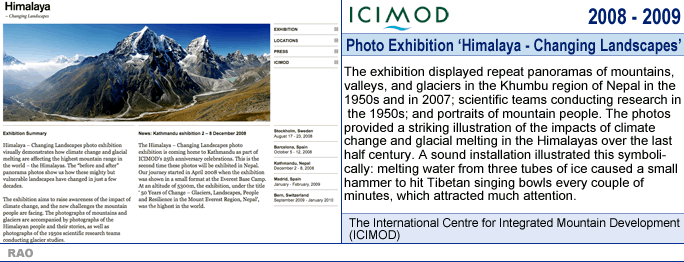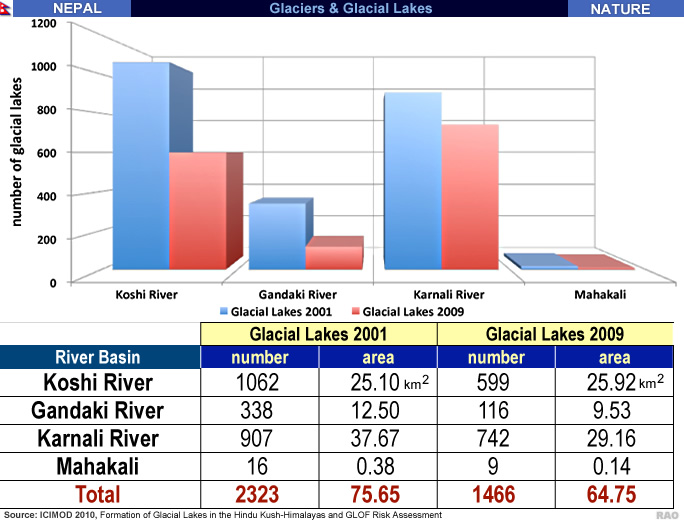 |
Nepal Himalayas Glaciers |
|
 |
Nepal Himalayas Glaciers |
|
|
 |
|
Nepal:
Climate change is real and happening now
|

|
 |
|
Himalayas:
Changing Landscapes
|
 |
|
Himalaya
- Changing Landscapes photo exhibition |
 |
During
the 1950s, Austrian and Swiss scientists conducted intensive studies of
the Everest region in Nepal taking photographs of the glaciers, mountains
and valleys. Around the same time, the Swiss glaciologist Fritz Müller
spent eight months in the region at locations above 5000 metres, studying
and photographing the Himalayan glaciers.
Now,
fifty years later, the black and white photographs taken by these scientists
are of immense value in trying to understand the impacts of climate change
on the world's highest mountain range, the Himalayas. Mountain geographer
Alton Byers has revisited many of the sites of the original photographs
and taken replicates, illustrating the changes in the landscape. The old
and new photographs have now been united in a unique photo exhibition:
Himalaya - Changing Landscapes. The exhibition is part of the 25th Anniversary
celebrations for ICIMOD and has been organised in partnership with the
BBVA Foundation.
"Only
five decades have passed between the old and the new photographs and the
changes are dramatic. Many small glaciers at low altitudes have disappeared
entirely and many larger ones have lost around half of their volume. Some
have formed huge glacial lakes at the foot of the glacier, threatening
downstream communities in case of an outburst", says Byers.
The
Himalaya - Changing Landscapes photo exhibition aims to raise awareness
of the impact of climate change and of the new challenges facing the mountain
people. The stunning repeat panorama views of mountains and glaciers are
accompanied by images of the Himalayan people and their stories, as well
as photographs of the scientists conducting glacier research in the 1950s.
Climate
change is affecting people around the globe, and this is especially evident
at the top of the world around Mount Everest and the high peaks of the
Himalayan mountain range. The greater Himalayan region has the largest
concentration of snow and ice outside the two poles. Warming temperatures
cause rapid melting of the glaciers, severely affecting the people downstream.
Ten river systems originating in the Himalayas bring water to a mountain
population of around 200 million, while the vast water basins downstream
are home to a further 1.3 billion people. In total 1.5 billion people -
a fifth of the world's population - depend on the Himalayan rivers for
their water supply.
The
Hindu Kush-Himalayan region is the highest, most complex mountain region
in the world. It extends more than 3500km over eight countries, from Afghanistan
in the north-west to Myanmar in the south-east. The area ranges from the
high plateau of Tibet and other mountain areas of China to the Ganges Basin
in India, and has the upland watersheds of the ten major Asian river systems.
Warming
in the Himalayan region has been much greater than the global average.
Weather patterns are becoming more unpredictable and extreme - dry seasons
become dryer and wet seasons wetter. This phenomenon is causing concern
over the long-term reduction in total water supply, affecting the lives
and livelihoods of the Himalayan people, especially in agriculture practices
and long-term food security.
In
the words of Dr. Andreas Schild, Director General of ICIMOD; "What we see
here at the Himalaya photo exhibition is just the tip of the iceberg. The
changes taking place are alarming, and the time to act is now. Scientific
evidence shows that the effects of globalisation and climate change are
being felt in even the most remote Himalayan environments. While climate
change is mostly caused by the highly industrialised parts of the world,
the effects are taking their toll in the sensitive mountain areas. The
signs are visible, but the in-depth knowledge and data from the Himalayan
region is largely missing. Global measures of scientific co-operation and
regional collaboration are needed to reduce this information gap.
What happens in this remote mountain region is a serious concern for the
whole world".
The
Himalaya - Changing Landscapes photo exhibition was first unveiled in a
customised format at the Mt. Everest Base Camp (5300m) in April 2008, making
it the highest photo exhibition in the world. For future exhibition
dates and locations please see www.changing-landscapes.com. Four-metre
long photo panels making up the exhibition. The entrance is free for the
general public.
|
Source:
ICIMOD, International Centre for Integrated Mountain Development 2008
|
 |
ICIMOD
The
International Centre for Integrated Mountain Development (ICIMOD) is an
independent 'Mountain Learning and Knowledge Centre' serving the eight
member countries of the Hindu-Kush-Himalayas - Afghanistan, Bangladesh,
Bhutan, China, India, Myanmar, Nepal and Pakistan - and the global mountain
community. ICIMOD is a non-political intergovernmental organisation which,
since 1983, has encouraged technical cooperation between governments in
the region and whose primary objective is to help promote the development
of environmentally sound mountain ecosystems and improve the living standards
of the mountain population. www.icimod.org
BBVA
Foundation
The
BBVA Foundation expresses the corporate responsibility of BBVA, a global
financial services group committed to the welfare of the societies where
it conducts its business. The Foundation supports knowledge generation,
scientific research and the promotion of culture, relaying the results
of its work to society at large. Among its preferred areas of activity
are basic sciences, conservation biology, biomedicine, the social sciences
and literary and musical creation. It has recently established the BBVA
Foundation Frontiers of Knowledge Awards to honor outstanding contributions
in areas such as climate change, ecology and conservation biology. www.fbbva.es
top
|
more information
|

|
| Snow, Ice, Glaciers, Glacial Lakes and Floods - Reports |
 |
| Himalayas |
 |
Snow, Ice, Glacier, Glacial Lakes and Floods Reports |
 |
|
Links |

|
 |
 |
External
link |
 |
International
Centre for Integrated Mountain Development
ICIMOD |
|
 |
 |
|
Annapurna I |
|







